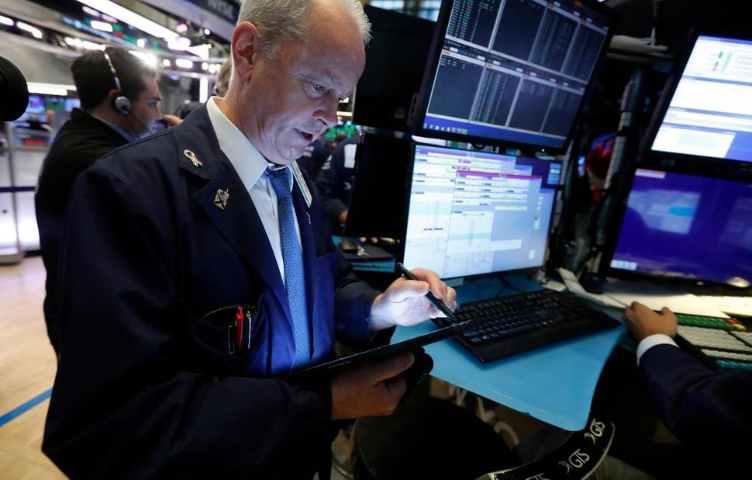U.S. stock indexes bobbed around their record levels Monday, as the curtain rose on what’s expected to be the weakest earnings reporting season in years.
NEW YORK — A wobbly day of trading ended with meager gains for U.S. stock indexes on Monday, enough to nudge them further into record territory, as the curtain rose on what’s expected to be the weakest earnings reporting season in years.
Financial stocks fell even though Citigroup said it made more money last quarter than analysts expected. Energy stocks were also weak, but gains for technology and health care stocks helped tip the S&P 500 and other indexes past the highs set on Friday.
The S&P 500 rose 0.53 points, or less than 0.1%, to 3,014.30 after drifting between a gain of 0.1% and a loss of 0.2% earlier in the day. The Dow Jones Industrial Average gained 27.13, or 0.1%, to 27,359.16, and the Nasdaq composite added 14.04, or 0.2%, to 8,258.19.
Stocks have jumped since early June on increasing expectations that the Federal Reserve will cut interest rates to help the economy, and investors are virtually certain that it will happen at the next Fed meeting at the end of this month. The only question, investors say, is how deeply the Fed will cut when it lowers rates for the first time in a decade.
Until then, the main drivers for the market will likely be the hundreds of earnings reports scheduled to come from big companies, showing how much profit they made from April through June. “It’s waiting for this really all important second-quarter earnings season to heat up,” said Thomas Martin, senior portfolio manager at Globalt Investments.
Expectations are generally dim, and Wall Street is forecasting a 3% drop in earnings per share for S&P 500 companies from a year ago. That would mark the first back-to-back drop in three years, according to FactSet. This week, roughly a fifth of the companies in the S&P 500 are set to report their second-quarter results.
Citigroup was one of the reporting season’s early headliners, but its stock initially fell as much as 2.4% after reporting better-than-expected results. Its stock recovered as the day progressed, and it ended Monday down only 0.1%.
Other banks, though, didn’t have as strong a recovery, and financial stocks in the S&P 500 dropped 0.5% for the second-sharpest loss among the 11 sectors that make up the index. JPMorgan Chase, which will report its second-quarter results on Tuesday, fell 1.2% and was the biggest individual drag on the S&P 500.
Every earnings reporting season, companies usually turn in results that top analysts’ expectations. That may be even easier to do this time around, with analysts forecasting the worst drop in quarterly earnings for the S&P 500 in three years at 3%, according to FactSet.
“The bar for corporate earnings has been set quite low, and we don’t think it will take much to surprise on the upside,” said Jon Adams, senior investment strategist at BMO Global Asset Management.
That’s why he said he’ll be paying close attention to which companies are able to grow their revenues despite the stronger dollar and weakening economic trends around the world, and not just which companies are beating earnings forecasts. He’s also focusing on companies able to keep their profit margins high, when wage growth for workers at many companies is starting to nudge higher.
Several economic reports are also on the schedule this week, including updates on retail sales, the housing industry and shoppers’ confidence. The U.S. economy has generally remained solid, but investors don’t expect this week’s reports to alter the direction of the Fed, which has already given hints about rate cuts given weakening economic trends around the world.
The White House’s repeated threats to raise tariffs has made companies at home more hesitant and hurt trade internationally. They’re a big reason that China on Monday reported its weakest quarter of economic growth in at least 26 years.
“You could make a case that the Fed shouldn’t need to cut in this market, but they’ve clearly prepared the market for a cut,” said Adams.
Energy stocks fell 0.9% Monday for the sharpest drop among the 11 sectors that make up the S&P 500. Lower prices for oil and natural gas dented shares across the industry.
Benchmark U.S. crude fell 63 cents to settle at $59.58 per barrel. Brent crude, the international standard, lost 24 cents to $66.48 a barrel. Natural gas dropped 5 cents to $2.41 per 1,000 cubic feet, heating oil fell 3 cents to $1.95 per gallon and wholesale gasoline lost 5 cents to $1.93 per gallon.
The price of gold edged up $1.30 to $1,413.50 an ounce, silver rose 13 cents to $15.29 an ounce and copper rose 2 cents to $2.71 a pound.
The yield on the 10-year Treasury dipped to 2.08% from 2.10% late Friday. The two-year Treasury yield, which is more affected by expectations of Fed rate moves, held steady at 1.83%.
In markets abroad, the FTSE 100 in London rose 0.3%, France’s CAC 40 inched up 0.1% and Germany’s DAX added 0.5%. South Korea’s Kospi slipped 0.2%, and the Hang Seng in Hong Kong rose 0.3%.
The dollar inched up to 107.90 Japanese yen from 107.81 late Friday. The euro slipped to $1.1259 from $1.1271, and the British pound fell to $1.2520 from $1.2572.

